SONGSEEDS - Three Chord Tricks
Conchordance
eBook :SONGSEEDS - Three Chord Tricks Conchordance is a systematic list of Three Chord Tricks that can be used as a reference book,song writing prompt or jamming tool. |
Paperbook Book :SONGSEEDS - Three Chord Tricks Conchordance is a systematic list of Three Chord Tricks that can be used as a reference book,song writing prompt or jamming tool. |
Bob Seger
|
|
Bob Seger was a mid-western boy on his own in California. |
|
LIVE Night Moves Kansas City, MO 12/2/06
Night Moves on YouTube
Hollywood Nights - LIVE Late 70's/early 80's
|
||
|
Martin manufacturers the acoustic guitar Bob Seger uses on his sell-out world tours.
|
|

MINOR SCALE THREE CHORD TRICKS
WITH PHRYGIAN SECOND SUBSTITUTION
As explained in BLOGoZON No. 85 every natural minor scale generates a predictable series of chords (built using a mixture of major and minor third intervals); with the simplest having 3 notes (triads) and the most complicated using all 7 notes of the major scale (thirteenths).
The simplest major scale, from a note naming point of view, is C major as it has ZERO sharp (♯) or flat (♭) notes. Similarly the A natural minor scale is the simplest minor scale (as it is really the C major scale re-ordered to start on A natural rather than C natural); a table of the scale follows:-
INTERVAL NUMBER |
||||||
1 |
2 |
♭3 |
4 |
5 |
♭6 |
♭7 |
NOTE NAMES |
||||||
A |
B |
C |
D |
E |
F |
G |
Using the 7 chords generated from the natural minor scale (Aeolian mode) there are a total of 35 chord progressions (when 3 chords are selected at one time) and these relationships have been tabulated for A minor to the right. As demonstrated by the table shown right each chord appears a total of 15 times (from a total of 35 chord progressions) The presence of the diminished chord produces a big problem from a pop music point of view (rather than jazz) as the sound of this chord is considered too difficult for most listeners. As the Bdim chord is contained in three-sevenths of the available chord progressions it leaves a limited number of usable 3 chord tricks (20 out of an original 35); hence an alternative chord is required to replace it. The solution to the replacement of the Bdim chord is arrived at by examining the complete minor scale harmony chart for all 15 key signatures (shown below) and identifying how many times an Am chord appears. |
|
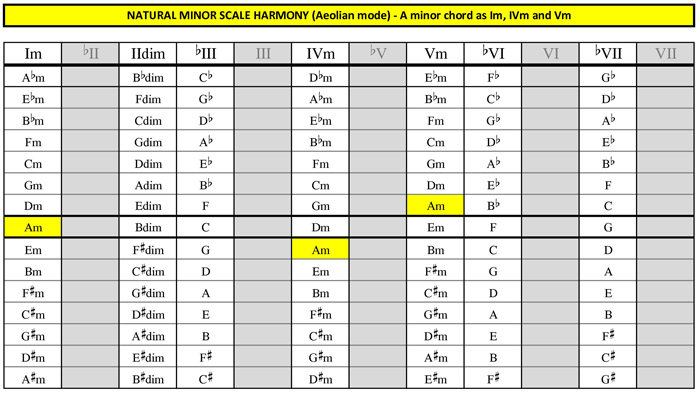
The Am chord appears a total of three times in the 15 available key signatures:-.
- as the Im chord in the key of A minor;
- as the IVm chord in the key of E minor;
- finally as the Vm chord in the key of D minor.
This produces two available solutions to the replacement of the Bdim chord in the 15 chord progressions where it makes an appearance (see above);this BLOGoZON examines the substitution chord produced where Am appears as the number Vm chord in the key of D minor.
The table that follows shows the natural minor scale generated harmony (3 note scale chords) for the keys of both A minor and D minor with the number Vm chord of D minor (Am) highlighted.

If the scale chords for the key of D minor are rearranged so that A minor is the starting chord this is known as the harmonized A phrygian mode; which is tabulated below:-

Thus the ♭II chord of the harmonized A phrygian mode (B♭ major chord) can be used as a substitution (replacement) chord for the IIdim of the harmonized A minor scale (B diminished chord); as highlighted in the tables that follow:-

The table above can also be generated for all seven SHARP major scales as defined by the CYCLE OF FIFTHS
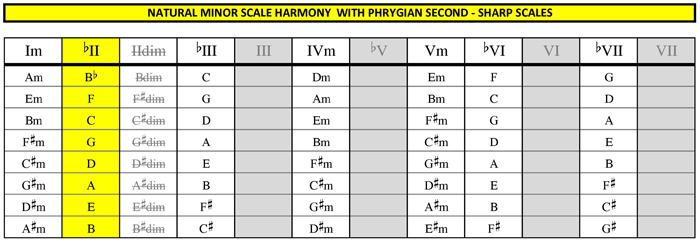
Similarly the table can be produced for the FLAT major scales as defined by the CYCLE OF FOURTHS
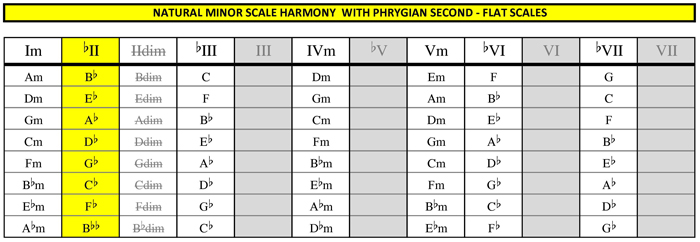
| Again using the 7 chords generated from the A minor scale (Aeolian mode) there are a total of 35 chord progressions (when 3 chords are selected at one time) and these relationships have been tabulated for a minor to the right. As previously demonstrated above each chord appears a total of 15 times (in the table shown right) and this now includes the substitution chord B♭. The problem sound created by the difficult Bdim chord has been solved by replacing it (substituting) with the B♭ major chord. As the Bdim chord was contained in three-sevenths of the available chord progressions it brings the number of usable 3 chord tricks back up to 35 (where Bdim represented 15 out of the original 35 chord progressions). |
|
Every one of the 35 numerically ordered 3 CHORD TRICKS (progressions) can be re-ordered a further 6 times, which produces a total of 210 potential SONGSEEDS for each and every key signature. An example table follows for chord progression number 1, which has a generalised relationship of Im, ♭II, ♭III :-
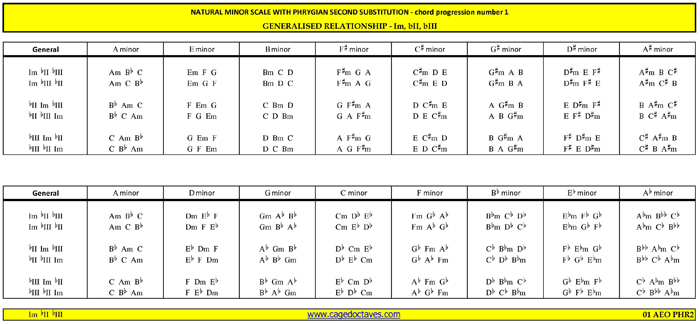
The question is "Has any of this music theory nonsense been used to write any decent songs that both sounded good and made some money for the writer?"
Fortunately the answer is a resounding YES and as Bob Seger is the subject of this weeks BLOGoZON the song in question is one of his biggest hit records - Night Moves - which uses a total of three 3-chord progressions (two of which involve the PHRYGIAN SECOND SUBSTITUTION method) for the chorus chord sequence.
The song in question is from his 1976 hit album, with the same name, Night Moves where a Im, ♭VII, ♭VI
(Em-C-D) THREE CHORD TRICK has been re-ordered to become the spectacularly succesful Im, ♭VII, ♭VI
(Em-D-C); with the ♭VII (D) middle chord being played again at the end producing a Im, ♭VII, ♭VI, ♭VII
(Em-D-C-D) start to the chorus.
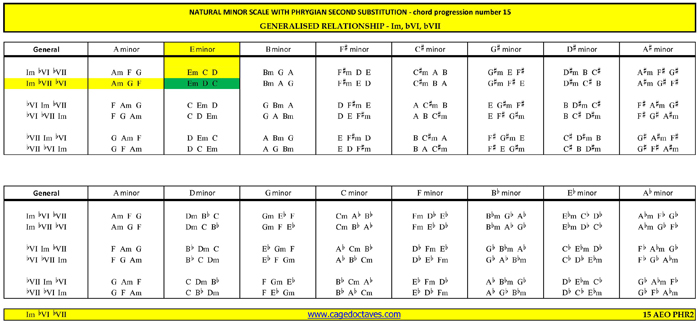
The chorus then moves on using two re-arrangements of the ♭II, ♭III
, ♭VII
(F-G-C) PHRYGIAN SECOND SUBSTITUTION THREE CHORD TRICK; starting with ♭III
, ♭II, ♭VI (G-F-C); followed by ♭VI
, ♭II, ♭III
(C-F-G) to complete the chorus.

|
She was a black-haired beauty with big, dark eyes, and points all her own, sittin' way up high |











